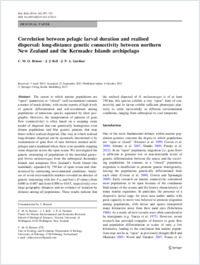Correlation between pelagic larval duration and realised dispersal: long-distance genetic connectivity between northern New Zealand and the Kermadec Islands archipelago
- Reisser, Céline M. O. Centre for Marine Environmental and Economic Research, School of Biological Sciences, Victoria University of Wellington, New Zealand - Unit of Ecology and Evolution, Department of Biology, University of Fribourg, Switzerland
- Bell, J. J. Centre for Marine Environmental and Economic Research, School of Biological Sciences, Victoria University of Wellington, New Zealand
- Gardner, J. P. A. Centre for Marine Environmental and Economic Research, School of Biological Sciences, Victoria University of Wellington, New Zealand
-
2013
Published in:
- Marine Biology. - 2014, vol. 161, no. 2, p. 297-312
English
The extent to which marine populations are “open” (panmixia) or “closed” (self- recruitment) remains a matter of much debate, with recent reports of high levels of genetic differentiation and self-recruitment among populations of numerous species separated by short geographic. However, the interpretation of patterns of gene flow (connectivity) is often based on a stepping stone model of dispersal that can genetically homogenise even distant populations and blur genetic patterns that may better reflect realised dispersal. One way in which realised long-distance dispersal can be accurately determined is by examination of gene flow of taxa between isolated archipelagos and a mainland where there is no possible stepping stone dispersal across the open ocean. We investigated the genetic structuring of populations of the intertidal gastropod Nerita melanotragus from the subtropical Kermadec Islands and temperate New Zealand’s North Island (the mainland), separated by 750 km of open ocean and characterised by contrasting environmental conditions. Analyses of seven microsatellite markers revealed an absence of genetic structuring with low F ST and Jost’s D values (from 0.000 to 0.007 and from 0.000 to 0.015, respectively) over large geographic distances and no evidence of isolation by distance among all populations. These results indicate that the realised dispersal of N. melanotragus is of at least 750 km, this species exhibits a very “open” form of connectivity and its larvae exhibit sufficient phenotypic plasticity to settle successfully in different environmental conditions, ranging from subtropical to cool temperate.
- Faculty
- Faculté des sciences et de médecine
- Department
- Département de Biologie
- Language
-
- English
- Classification
- Biological sciences
- License
-
License undefined
- Identifiers
-
- RERO DOC 205468
- DOI 10.1007/s00227-013-2335-0
- Persistent URL
- https://folia.unifr.ch/unifr/documents/303251
Statistics
Document views: 80
File downloads:
- Fichier principal: 209
